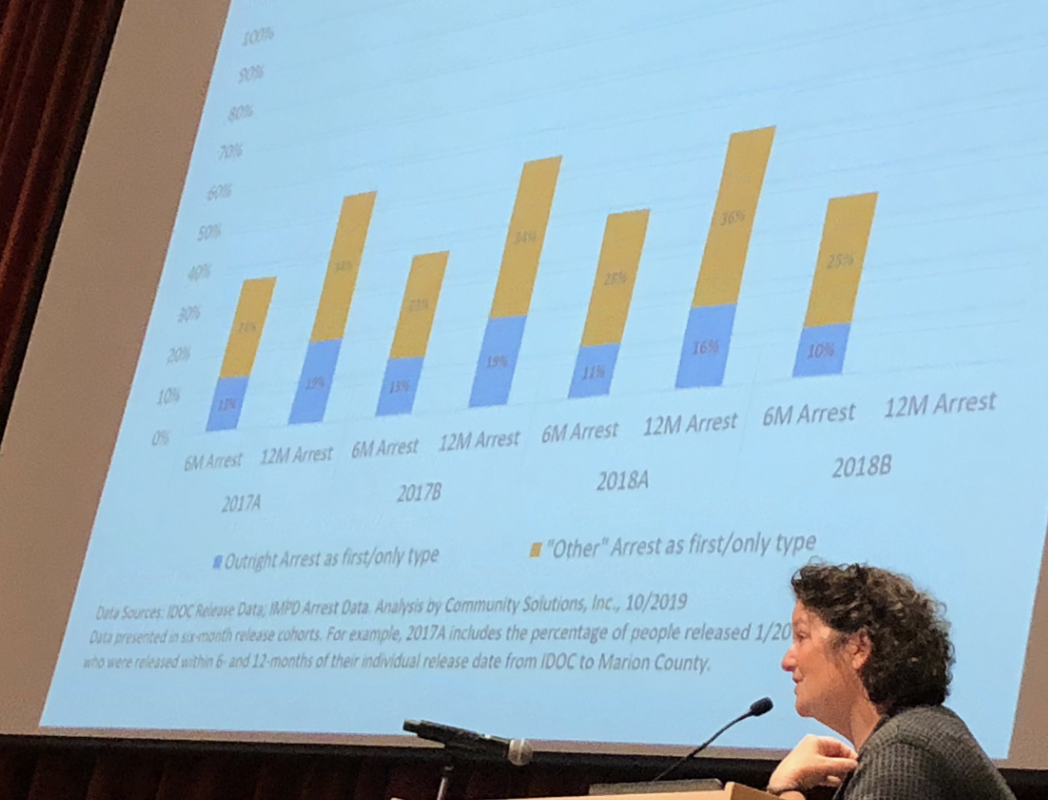 Taxpayers pay millions to keep lawbreakers off the street, yet when the courts decide these folks are ready to be released, they often find themselves in situations that tend to send them right back behind bars. Recidivism serves no one, and while repeat criminals must be incarcerated, too many go back to prison due to technical violations not crimes.
Taxpayers pay millions to keep lawbreakers off the street, yet when the courts decide these folks are ready to be released, they often find themselves in situations that tend to send them right back behind bars. Recidivism serves no one, and while repeat criminals must be incarcerated, too many go back to prison due to technical violations not crimes.
In the picture, left, Lena Hackett, CEO of Community Solutions is explaining a graph that breaks down into percentages those who returned to jail or prison for various reasons. The smaller blue portions of the bars represent the recidivism percentage of those who committed a new crime and were reincarcerated. But that much larger gold portion represents those who are returned to prison because they have violated technicalities of their release as set out by a judge. If a reentrant misses a court-ordered meeting or an evaluation that is supposed to happen, he has made a technical violation of his release. These mis-steps happen with some frequency as life for a newly-released person is not completely under his or her own control and then there's the great difference between a highly controlled prison environment in which he has lived and the overwhelming freedom a new reentrant must negotiate. At the end of the day, these missed meetings and small infractions can lead to violations and violations often lead to rearrest. (As reflected in the gold bars.)
Many times times the judge orders an ankle bracelet to be worn. These devises are made to track the wearer so that he doesn't go where the judge has ruled he cannot go. But if a reentrant's job sends him to a person's home or on a route not approved by the court, he will again be in technical violation of his release. For a reentrant who doesn't have a vehicle it becomes doubly hard. When the bus route runs through a restricted area or when a person who is driving him around in their car is told they need to drive miles out of the way to avoid a certain street, they may (and people do) refuse—initiating technical violations.
There are about 4500 ankle bracelets in use in Indianapolis. They cost $5,000 each which totals about $20 million per year. Previously paid for by taxpayers, the cost has now been shifted to users. That seems appropriate on the surface, but it really doesn't work well. Here you are, a recently released prisoner. You don't have a job and if you do, it barely pays for shared housing and a meal every day, but probably not the $465 a month to pay for the court-mandated ankle accessory. If you can't make the mandated payments the debt accrues and police and finally a collection agency will be knocking on your door. And, they are very serious about collecting. Meanwhile, there is plenty of anecdotal evidence that some entrepreneurial types will deal drugs or raise money in other less-than-legal methods just to pay the ankle-bracelet toll.
A trucking company manager who hires many reentrants told me that there is so much reporting necessary, he can't switch a bracelet wearer to another truck route when he has to, he has to send them home. He's required to document everywhere the person goes in his work route and when you multiply that times 10 or 20 reentering employees, eventually the company has to stop hiring reentrants.
Ankle bracelets are not unfair and they work well in some cases, but for those reentrants who are making low wages or no wages and have no transportation, for those trying to be responsible, electronic monitoring is often a burden that can become a barrier to the success we all want to see. And here's the weird thing: Indianapolis has more ankle bracelets than any other large city in the country, including Los Angeles and New York. Why is that? And why are we slapping them on so many people here?
Would love to know,
Nancy








